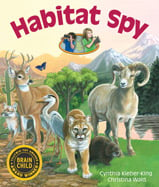On Meadowview Street is a wonderful simple story about a little girl named Caroline who moves into a new house. All of the houses on the street look exactly the same. So do all the yards. Caroline wants to go explore her street to see if there really is a meadow on Meadowview Street when she notices a pretty pink flower growing in her yard. She convinces her dad not to mow over the little flower and sets up a twine boundary line around the flower.
Soon she notices another flower growing outside her flower sanctuary. She increases the size of the preserve. She increases the size of the preserve again and again to accommodate all of the interesting plants that start to grow. She begins to notice butterflies coming to her preserve.
Caroline's dad sells the mower, they plant some trees, build bird houses, and put in a small pond. Pretty soon other neighbors down the street start to follow suit.
As someone who studied 'environmental studies' in college, this book has found a place in my heart. I love that it encourages children to notice the ecology in their own backyard. I love that it encourages people to give up their lawn mowers and stop fertilizing their grass. (Please. If you're reading this, stop fertilizing your grass too.)
On Meadowview Street
By Henry Cole
I would make a couple critiques of the book, however. One is that most adults will not willingly and easily give up mowing their lawn and let their lawn to go to seed. Another is that if we were to all do it just that way-- stop mowing and see what happens-- we would most likely just have a bunch of invasive weeds pop up, like dandelions. We all wouldn't have the idyllic pink, orange, blue and white flowers pictured in the book. Also, I would have really liked to see the author/illustrator give detail to the plants and birds that start to show up in Caroline's backyard, since one of the purposes of this story is to get kids to begin to notice the plants and animals they could find at home. One spread at the end of the story shows animals and a few plants that Caroline started to see, but I would have liked to see these throughout!



